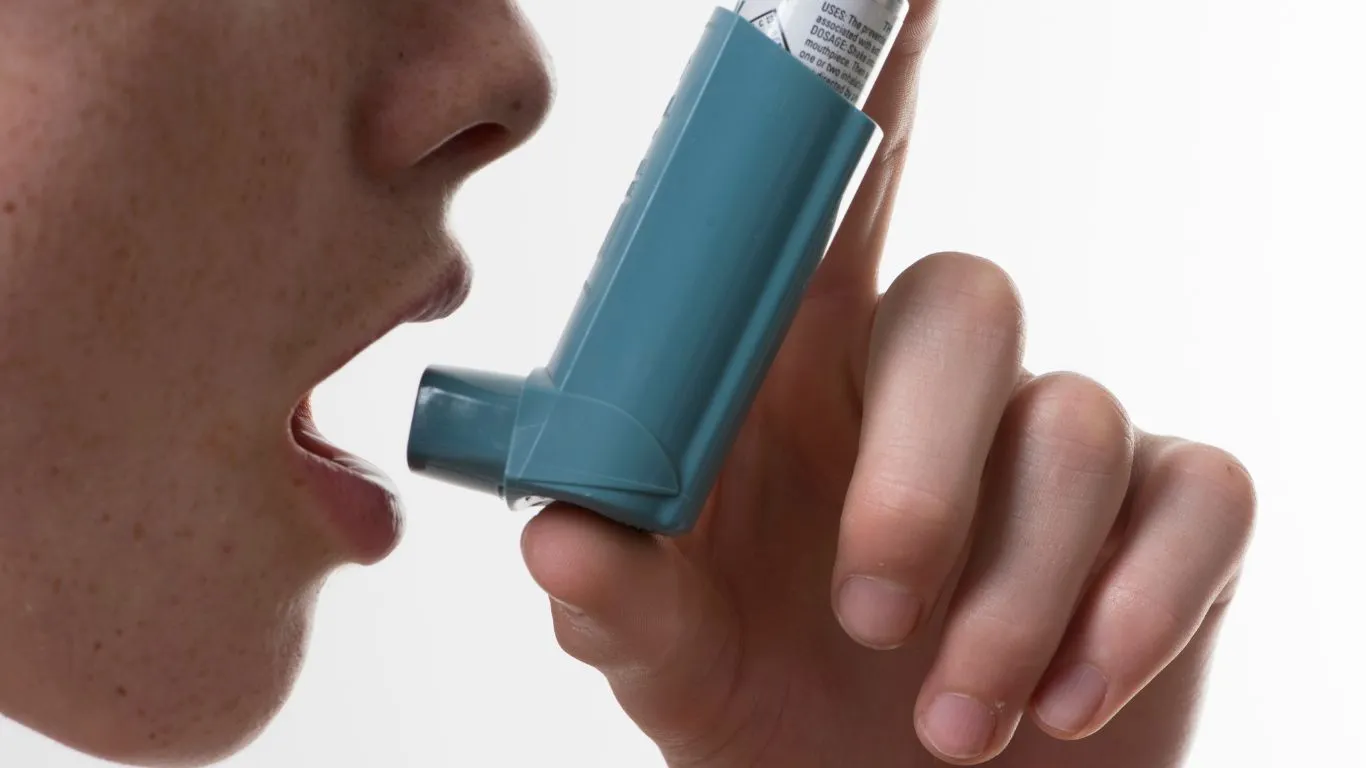Can Asthma Cause Upper Body Weakness? Discover the Unexpected Connection
As a pulmonary nurse, I’ve seen firsthand how asthma affects people’s lives in many different ways. One of the most common, yet often overlooked, concerns that asthma sufferers face is upper body weakness. You might be wondering, “Can asthma cause upper body weakness?” Well, the answer is a bit more complicated than you might think, and it’s not something people typically connect right away. In fact, it’s not just about feeling tired or winded; asthma can lead to physical weakness in your upper body muscles, especially if it’s not managed well. The connection might not seem obvious at first, but if you’ve ever found yourself gasping for air or using extra energy just to breathe, you’re likely familiar with the toll it can take on your body. Let’s dive in and explore this phenomenon further, using both medical insight and personal experience to explain how asthma and upper body weakness are linked.
How Asthma Impacts Your Upper Body Muscles

It’s important to understand that asthma doesn’t just affect your lungs—it can have a ripple effect on your entire body. The main issue here is the strain that occurs when your lungs are struggling to get enough oxygen into your bloodstream. When you’re having difficulty breathing, your muscles, including those in your chest, neck, and upper body, are forced to work overtime. Over time, this can result in muscle fatigue and weakness.
The Role of the Respiratory Muscles
Asthma primarily causes difficulty in expelling air from the lungs. This is especially true during an asthma attack when the airways are inflamed and narrowed. Your diaphragm and the intercostal muscles between your ribs are vital for breathing. When your breathing becomes labored, these muscles work harder to help you take in air, which can lead to them becoming exhausted. The more often this happens, the more you might feel like your upper body muscles are weak or even fatigued.
Posture and the Upper Body
Have you ever noticed that people with asthma often develop a hunched posture? This is another common physical side effect of asthma. When breathing becomes difficult, individuals may adopt a “leaning forward” position, using their arms to support their upper body. While this might provide temporary relief, it can also put a strain on the upper body muscles, contributing to weakness and discomfort. Over time, this posture can lead to imbalances in muscle strength and flexibility, especially in the upper back, shoulders, and neck.
The Impact of Asthma Medication on Muscle Weakness

If you’ve been living with asthma for a while, you’re likely familiar with the various medications prescribed to manage the condition. Inhalers, steroids, and other treatments are designed to open up the airways and reduce inflammation. However, these medications can have side effects that impact the rest of your body—particularly your muscles.
Steroid Use and Muscle Atrophy
One of the most common treatments for severe asthma is corticosteroids, which help reduce airway inflammation. While steroids are effective in managing asthma symptoms, they can contribute to muscle atrophy (weakening or wasting of muscles) if used for long periods. As a nurse, I’ve seen many patients who have struggled with steroid-induced muscle weakness. If you’ve been on steroids for a long time, your upper body muscles may feel more sluggish or weaker due to this side effect.
The Link Between Asthma and Reduced Physical Activity
Another contributing factor to upper body weakness is the lack of physical activity that often accompanies asthma. When asthma symptoms are severe, it’s common for people to avoid exercise or physical activities, fearing that it may trigger an attack. However, this lack of exercise can lead to muscle deconditioning. For example, if you’re not regularly engaging your chest and shoulder muscles, they may start to weaken over time, exacerbating the feeling of upper body weakness.
Why Upper Body Weakness is Often Overlooked

Upper body weakness is a common symptom among asthma patients, but it’s often overlooked. This is partly because the focus tends to be on respiratory symptoms like coughing, wheezing, and shortness of breath. As a result, the subtle signs of muscle weakness can get brushed aside. You might not immediately connect your upper body fatigue with your asthma symptoms, especially if your breathing feels better once the attack subsides. However, if you consistently experience weak muscles in your upper body, it’s worth discussing it with your doctor or a healthcare provider.
Signs You Might Be Experiencing Upper Body Weakness
- Feeling tired or weak in the shoulders, neck, or arms after breathing difficulties
- Experiencing difficulty lifting objects or performing daily tasks that require upper body strength
- Noticing a hunched posture or leaning forward to breathe
- Frequent muscle cramps or spasms in the chest or upper back area
Why it’s Important to Address Upper Body Weakness
Ignoring upper body weakness in asthma patients can lead to long-term complications, including chronic pain, muscle imbalances, and even restricted movement. The more you engage in managing your asthma and maintaining a healthy lifestyle, the less likely you are to experience these physical weaknesses. By staying on top of your asthma management plan and incorporating physical therapy or strengthening exercises, you can help prevent your upper body muscles from becoming a weakness that limits your everyday activities.
How to Strengthen Your Upper Body with Asthma
While it might seem counterintuitive to think about exercising when you’re already struggling with breathing, it’s actually one of the best ways to manage both your asthma and muscle strength. The key is to start slow, listen to your body, and work closely with your healthcare provider to ensure you’re doing exercises that are safe and effective. Building up your upper body strength can help relieve some of the strain on your muscles and improve your posture, making it easier to breathe in the long run.
Building Upper Body Strength Despite Asthma

Now that we’ve talked about how asthma can contribute to upper body weakness, let’s explore how you can combat this issue and actually build up your upper body strength—despite asthma. As someone who’s worked in pulmonary care for years, I can tell you that it’s possible to regain strength, even if you’ve struggled with asthma-related fatigue. It’s all about finding the right balance between asthma management and building muscle. You just need to be mindful of your limits and work with your body, not against it.
Start with Breathing Exercises
Before diving into any strength-building exercises, one of the first things I always recommend to asthma patients is to work on their breathing techniques. The more efficient your breathing becomes, the less strain it will put on your muscles. It might sound simple, but focusing on diaphragmatic breathing—where you breathe deeply into your belly rather than shallow chest breaths—can help strengthen the muscles used for respiration. Over time, this can lead to better oxygen flow and less muscle fatigue during asthma flare-ups.
Incorporating breathing exercises into your daily routine doesn’t require much. Even just five to ten minutes a day can make a noticeable difference. Plus, it’s a great way to relax and de-stress, which can also help with asthma management. I often recommend the “4-7-8” technique: inhale for 4 seconds, hold for 7 seconds, and exhale for 8 seconds. This simple practice can improve lung function and help you feel more in control of your breathing during physical activities.
Low-Impact Strength Training for Asthma Sufferers
Once your breathing exercises are in place, it’s time to add some strength training into your routine. However, it’s important to start slow and focus on exercises that are gentle on the lungs and easy on the joints. Low-impact exercises are your best bet. Resistance training with light weights or bodyweight exercises like push-ups and planks can help strengthen your upper body without triggering asthma symptoms. Trust me, even small steps make a difference.
For example, I’ve worked with many asthma patients who’ve seen progress by incorporating simple arm exercises, like bicep curls or shoulder presses. Start with light weights, maybe 2 to 5 pounds, and gradually increase as you get stronger. The key is consistency. If you don’t overexert yourself, you’ll be able to build up muscle strength without compromising your asthma management. It’s all about creating a steady pace that works for you.
Choosing the Right Exercise Routine for Asthma

Exercise can sometimes feel daunting if you’ve got asthma. Many of my patients worry that exercise will trigger an asthma attack or leave them gasping for air. But it doesn’t have to be that way. When you approach exercise in the right way—starting with activities that won’t overstrain your lungs—you can experience significant benefits for both your upper body strength and overall health.
Swimming: A Low-Impact, High-Reward Activity
One exercise I absolutely love recommending for people with asthma is swimming. If you’ve ever tried swimming, you know that it’s a full-body workout that focuses on strength, endurance, and flexibility. But here’s the thing: it’s also incredibly easy on your lungs. The moist air around a pool can help keep your airways from drying out, which reduces the likelihood of an asthma flare-up.
Even if you’re new to swimming, starting with light laps or water aerobics can help you build upper body strength without putting unnecessary strain on your breathing. Plus, the water provides resistance, making it a great low-impact exercise that strengthens the arms, chest, and shoulders while being kind to your lungs. I’ve seen patients improve their lung capacity and strength simply by committing to a few sessions a week.
Yoga: Breathing and Stretching for Strength
If swimming’s not your thing, yoga can be another great option. Many people with asthma find that practicing yoga regularly helps with both their muscle strength and breathing control. Yoga combines gentle stretches with deep breathing techniques, which is perfect for those who need to focus on strengthening the upper body without causing too much strain on the lungs.
I often suggest starting with a gentle flow or hatha yoga, which focuses on slow movements and controlled breathing. Poses like downward dog, plank, and cobra target the arms, shoulders, and chest—key areas that can become weak in asthma patients. Plus, yoga promotes flexibility and helps with posture, which, as we discussed earlier, can alleviate some of the tension that causes upper body discomfort. Over time, these practices can significantly improve upper body strength and respiratory function.
How to Prevent Asthma Flare-Ups During Exercise

We’ve talked about how to strengthen your upper body, but I’m sure you’re also wondering how to avoid those dreaded asthma flare-ups during physical activity. As someone who has worked with many patients navigating the challenges of asthma and exercise, I can say that it’s all about preparation. If you follow a few simple steps, you can minimize the risk of triggering symptoms while you’re working on building your muscles.
Always Have Your Inhaler on Hand
It might sound like a no-brainer, but I cannot stress enough how important it is to always carry your inhaler during exercise. Even if you feel like your asthma is under control, it’s better to be prepared than to risk a flare-up. I’ve seen too many people struggle during exercise simply because they didn’t have their inhaler nearby. If you’re planning on doing a more intense workout, use your inhaler as prescribed before you start, just to help open up your airways and make breathing easier.
Warm Up and Cool Down
Warming up and cooling down are crucial steps in preventing asthma symptoms from flaring up during exercise. A proper warm-up helps prepare your lungs and muscles for physical activity, and a cool-down allows your body to recover gradually. A gentle 5-10 minute walk or light stretching before and after any workout can help ease your body into and out of the activity. I often recommend that my asthma patients start with a warm-up that focuses on breathing exercises to get their lungs primed for the work ahead.
Avoid Exercise in Extreme Weather Conditions
Extreme heat, cold, or dry air can irritate your airways and trigger asthma symptoms. If you’re planning on exercising outside, try to avoid extreme weather conditions. Exercising indoors, like at a gym or in a heated or air-conditioned space, is often a safer option. If you do decide to go outside, make sure to wear a scarf or mask over your nose and mouth to help warm the air you breathe in during colder months.
Maintaining Long-Term Upper Body Strength with Asthma

We’ve covered a lot of ground in the past couple of sections, from understanding how asthma affects upper body muscles to practical tips for strengthening those muscles despite asthma. But let’s talk about something equally important: maintaining that hard-earned strength in the long term. It’s easy to start a workout routine with enthusiasm, but staying consistent can be a challenge, especially if your asthma symptoms flare up or you get discouraged by the slow pace of progress. As someone who’s seen patients come and go over the years, I can tell you that consistency is key—and that’s where patience and perseverance come in.
Consistency is the Secret Ingredient
When it comes to building and maintaining upper body strength with asthma, consistency really is the secret ingredient. I’ve seen patients who have made great progress in just a few months, but then they start skipping workouts because their asthma symptoms get in the way or they get frustrated with the slow progress. But here’s the thing: building strength takes time. Whether you’re working with light weights or using bodyweight exercises, the goal is to stay consistent. Even if you have to modify the routine on some days, doing something is better than doing nothing at all.
One strategy I recommend to patients is to break up their workouts into manageable chunks. For example, rather than committing to a full hour of exercise, start with 20-30 minutes a day, 3-4 times a week. If you feel like you’re too fatigued, you can always split up the session into two shorter sessions. The goal is to make exercise feel like a natural part of your routine, not an overwhelming task that you dread.
Tracking Your Progress
Tracking progress is an incredibly useful tool, not just for asthma patients, but for anyone working on a fitness goal. I recommend keeping a workout journal or using a fitness app to record your workouts and note any changes you’ve observed in your body. For example, if you notice that you’re lifting heavier weights or performing more push-ups than you could a few weeks ago, take pride in that progress. Tracking your success can motivate you to push forward, especially on days when you’re feeling frustrated with your asthma or muscle weakness. Plus, it’s a great way to discuss your progress with your healthcare provider and make any necessary adjustments to your asthma treatment plan.
Recognizing and Managing Setbacks

Of course, the road to maintaining long-term strength won’t always be smooth. There will inevitably be days when your asthma symptoms flare up, or when you feel like you’re just not making the progress you expected. Setbacks are a normal part of any journey, especially when managing a chronic condition like asthma. The important thing is to recognize these setbacks, adapt, and keep going.
Don’t Let Asthma Flare-Ups Discourage You
If you’ve had a few great weeks of working out, only to find yourself struggling with shortness of breath or coughing during exercise, don’t be too hard on yourself. Asthma flare-ups are going to happen from time to time. When that happens, the best thing to do is take a step back, rest, and allow your body to recover. It’s tempting to push through the discomfort, but trust me, giving yourself time to heal will pay off in the long run.
If a flare-up happens during exercise, take a break and use your inhaler if needed. If the symptoms persist, it might be worth revisiting your asthma management plan with your doctor to see if any adjustments are needed. Sometimes, flare-ups happen because your treatment plan isn’t fully aligned with your physical activity level, and small tweaks (like adjusting the dosage or trying a different inhaler) can make all the difference.
Rest Is Part of the Process
Another factor that’s easy to overlook when trying to build upper body strength is the importance of rest. It might seem like you should be working out every day, especially if you’re trying to build muscle. However, rest is crucial for muscle recovery, and without it, your muscles won’t have time to rebuild and get stronger. I always tell my patients: listen to your body. If you’re feeling particularly fatigued or if you’ve had an asthma flare-up, give yourself permission to rest. Pushing too hard without adequate recovery will only lead to burnout and can negatively affect your asthma control.
Additional Tips for Asthma Patients to Improve Overall Strength
As we’ve discussed, focusing on upper body strength is essential, but it’s also important to consider overall fitness and how it impacts your asthma management. A holistic approach to strength-building will make a world of difference in improving your respiratory function and reducing the impact of asthma on your daily life.
Focus on Full-Body Exercises
While upper body exercises are important, don’t forget about your lower body and core muscles. Strengthening these areas can make it easier for your upper body to do its job. For instance, squats, lunges, and deadlifts are great full-body exercises that work multiple muscle groups at once. Strengthening your legs and core will improve your overall muscle endurance and stability, making it easier to maintain a strong upper body as well. Plus, working on your entire body can help with overall fitness, which will make breathing easier during physical activity.
Incorporate Cardio into Your Routine
Another important piece of the fitness puzzle for asthma patients is cardiovascular exercise. While asthma may make cardio a little more challenging, it’s still incredibly beneficial for improving your lung capacity and overall stamina. Light activities like walking, cycling, or using an elliptical machine can help you build cardiovascular endurance without pushing your body too hard. If you’re new to cardio exercises, start slow, and gradually increase the intensity as you feel more comfortable.
The key to effective cardio for asthma patients is pacing. Don’t try to run a marathon on your first try. Instead, start with moderate activities that raise your heart rate without overtaxing your lungs. And of course, always have your inhaler with you just in case you need it.
Disclaimer
As always, this article is not a substitute for professional medical advice. If you have asthma and are considering starting an exercise routine or making changes to your treatment plan, please consult with your healthcare provider. They can help you develop a safe, effective plan that works for your unique situation. Asthma is a chronic condition, and managing it successfully requires a combination of personalized care, proper medication, and an understanding of your body’s limits. Stay informed, stay safe, and take it one step at a time.
For more information on asthma and exercise, I recommend visiting trusted resources such as the Health.com website or the National Institutes of Health (NIH).

Bianca Nala is a compassionate Nurse Practitioner with a strong background in primary and respiratory care. As a health writer for Healthusias.com, she combines her clinical expertise with a talent for clear, relatable storytelling to help readers better understand their health. Bianca focuses on topics like asthma, COPD, chronic cough, and overall lung health, aiming to simplify complex medical topics without losing accuracy. Whether she’s treating patients or writing articles, Bianca is driven by a single goal: making quality healthcare knowledge accessible to everyone.






